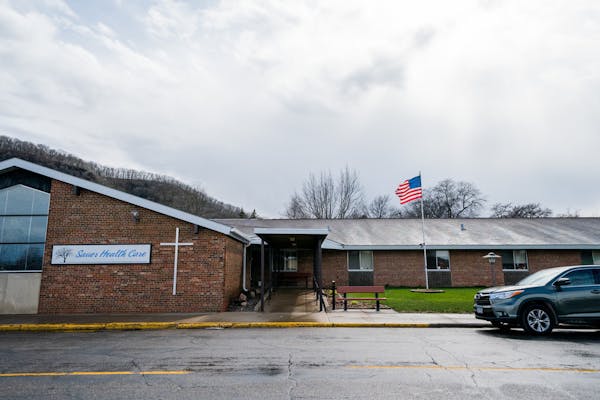Exhausted Minnesotans are anxious to know when the COVID-19 pandemic will end in their state, but another vital question remains:
When did this whole thing begin?
The U.S. Centers for Disease Control and Prevention reported Friday that COVID-19 was likely spreading in some pockets of the country in January or early February — before the nation's first community-acquired infection was detected on Feb. 27 in Washington state.
A University of Minnesota researcher similarly is out to establish whether the virus had already reached Minnesota by that time. On Saturday, it is expected the state will surpass more than 1,000 COVID-19 deaths and 24,000 known illnesses.
The U's Dr. Mark Schleiss said he can't ignore the patients with mysterious ailments he treated in early 2020 — including those with loss of smell and taste that has become a hallmark symptom of COVID-19.
"Anybody who has a bad cold has an altered sense of smell ... but it's another thing to just sort of have that sense vanish," said Schleiss, a pediatrician and molecular virologist. "My hunch is the virus was circulating at least in February but possibly in January."
Schleiss' research also could address how the virus affects children, including its potential role in a newly discovered Multi-System Inflammatory Syndrome in Children.
The Minnesota Department of Health on Friday confirmed two such cases in children, both of whom are hospitalized. Most children recover, but some cases mimic toxic shock syndrome and cause rashes, digestion troubles and problems with organs.
Nearly three months after reporting its first COVID-19 case, Minnesota as of Friday reported a total of 23,531 lab-confirmed cases as well as 996 deaths from the respiratory disease that is caused by a novel coronavirus. The number of patients needing hospitalization for COVID-19 reached 592 on Friday, and included 259 patients who needed intensive care.
Confirmation of another 590 cases of COVID-19 in Minnesota on Friday halted a five-day run in which the state's daily case count had been declining.
State Health Commissioner Jan Malcolm said that social distancing efforts and a recent stay-at-home order slowed the growth of the pandemic in Minnesota, which is why its peak is still to come while other states are already reporting declining case numbers.
Malcolm warned in a statement Friday that Minnesota is at a vulnerable point, particularly with so much person-to-person interaction and people arriving from other states to join protests over the Memorial Day death of George Floyd while he was being restrained by police.
"The Twin Cities remain a hot spot for COVID-19 spread," she wrote. "In fact, nationwide, we are one of the communities most vulnerable to rapid increases in the spread of the virus, given where we are in the course of the epidemic."
Searching for clues
An earlier presence of the virus in Minnesota could have undermined initial efforts to slow its introduction. In February, state health officials primarily advised Minnesotans to stock up on supplies if they needed to be quarantined, and to avoid the spread of germs by washing hands and covering coughs.
The state's first case in an elderly Ramsey County individual was reported March 6.
Schleiss is addressing that question through repurposing specimens he has been collecting from newborns of consenting families for a study of the cytomegalovirus — a common cause of birth defects.
Gaining permission to look at samples of babies born as far back as November 2019, Schleiss this week started conducting diagnostic testing to see how many had any trace of the novel coronavirus, known as SARS-CoV-2019.
"It could give us clues as to how the virus has worked its way around the world," he said.
The study is one of 59 funded by U mini-grants to examine the pandemic. Other studies using this funding sought to develop a low-cost emergency ventilator, assess how COVID-19 affects cancer outcomes, and examine whether social media could be used to rapidly implement social distancing and pandemic response strategies.
The U also launched one of the first randomized trials of hydroxychloroquine to see if the existing malaria drug could treat COVID-19 cases or prevent symptoms in people exposed to the virus. Publication of the U's trial results is expected in the next week or so.
The CDC report concluded an earlier-than-known community spread of the coronavirus in the U.S. based on analysis of four data sets — including emergency department records from counties with some of the first known COVID-19 cases — to see if patients had been coming in earlier with similar symptoms that hadn't been recognized.
Schleiss said his research could identify not just the timing of COVID-19's arrival in Minnesota, but also the subtype of the coronavirus that was involved in early infections.
Studies suggest that initial West Coast cases came from a viral strain that emerged in Wuhan, China, but that the East Coast surge might have started with a genetic variant that had spread widely in Europe.
COVID-19 has been harshest on the elderly — with Minnesotans 70 and older suffering 13% of the known cases so far but 82% of the deaths. Among all deaths, 811 involved residents of long-term care or assisted-living facilities.
Among 6,312 known cases of Minnesotans 29 and younger, none have died. Six people in their 30s in Minnesota have died from COVID-19, including someone this week with no other apparent health problems.
Identifying the virus in newborn samples could add to an understanding of how it affects children differently, Schleiss said, and how it contributes to the new and mysterious multiorgan syndrome.
"The question of what is going on in the newborn infants," he said, "is unresolved."

Want to share info with the Star Tribune? How to do it securely

'Safe recovery sites' would offer syringes, naloxone and more to people using drugs. The plan could be in peril.
New Minnesota GOP leaders seek peace with party's anti-establishment wing

Who is Republican Lisa Demuth, Minnesota's first House speaker of color?

